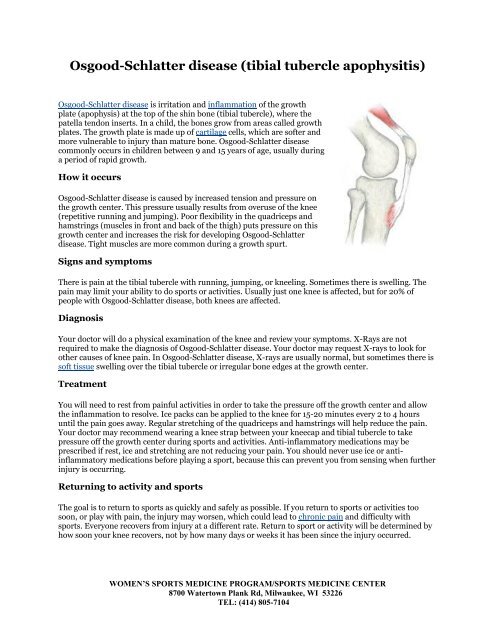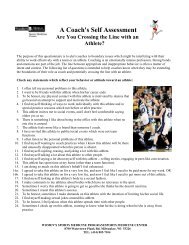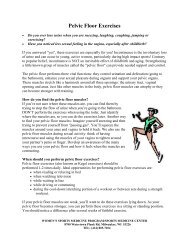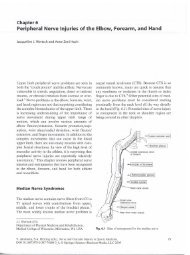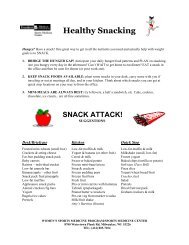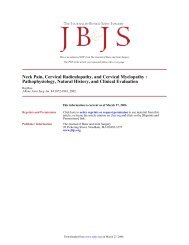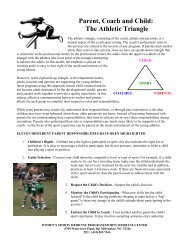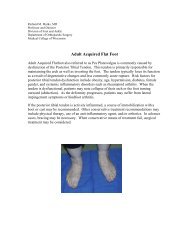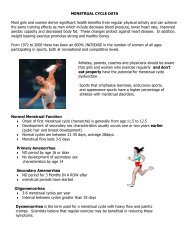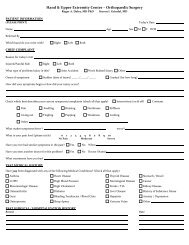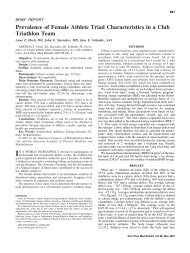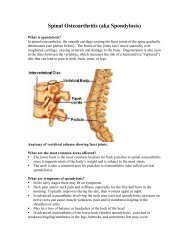Osgood-Schlatter disease (tibial tubercle apophysitis)
Osgood-Schlatter disease (tibial tubercle apophysitis)
Osgood-Schlatter disease (tibial tubercle apophysitis)
Create successful ePaper yourself
Turn your PDF publications into a flip-book with our unique Google optimized e-Paper software.
<strong>Osgood</strong>-<strong>Schlatter</strong> <strong>disease</strong> (<strong>tibial</strong> <strong>tubercle</strong> <strong>apophysitis</strong>)<br />
<strong>Osgood</strong>-<strong>Schlatter</strong> <strong>disease</strong> is irritation and inflammation of the growth<br />
plate (apophysis) at the top of the shin bone (<strong>tibial</strong> <strong>tubercle</strong>), where the<br />
patella tendon inserts. In a child, the bones grow from areas called growth<br />
plates. The growth plate is made up of cartilage cells, which are softer and<br />
more vulnerable to injury than mature bone. <strong>Osgood</strong>-<strong>Schlatter</strong> <strong>disease</strong><br />
commonly occurs in children between 9 and 15 years of age, usually during<br />
a period of rapid growth.<br />
How it occurs<br />
<strong>Osgood</strong>-<strong>Schlatter</strong> <strong>disease</strong> is caused by increased tension and pressure on<br />
the growth center. This pressure usually results from overuse of the knee<br />
(repetitive running and jumping). Poor flexibility in the quadriceps and<br />
hamstrings (muscles in front and back of the thigh) puts pressure on this<br />
growth center and increases the risk for developing <strong>Osgood</strong>-<strong>Schlatter</strong><br />
<strong>disease</strong>. Tight muscles are more common during a growth spurt.<br />
Signs and symptoms<br />
There is pain at the <strong>tibial</strong> <strong>tubercle</strong> with running, jumping, or kneeling. Sometimes there is swelling. The<br />
pain may limit your ability to do sports or activities. Usually just one knee is affected, but for 20% of<br />
people with <strong>Osgood</strong>-<strong>Schlatter</strong> <strong>disease</strong>, both knees are affected.<br />
Diagnosis<br />
Your doctor will do a physical examination of the knee and review your symptoms. X-Rays are not<br />
required to make the diagnosis of <strong>Osgood</strong>-<strong>Schlatter</strong> <strong>disease</strong>. Your doctor may request X-rays to look for<br />
other causes of knee pain. In <strong>Osgood</strong>-<strong>Schlatter</strong> <strong>disease</strong>, X-rays are usually normal, but sometimes there is<br />
soft tissue swelling over the <strong>tibial</strong> <strong>tubercle</strong> or irregular bone edges at the growth center.<br />
Treatment<br />
You will need to rest from painful activities in order to take the pressure off the growth center and allow<br />
the inflammation to resolve. Ice packs can be applied to the knee for 15-20 minutes every 2 to 4 hours<br />
until the pain goes away. Regular stretching of the quadriceps and hamstrings will help reduce the pain.<br />
Your doctor may recommend wearing a knee strap between your kneecap and <strong>tibial</strong> <strong>tubercle</strong> to take<br />
pressure off the growth center during sports and activities. Anti-inflammatory medications may be<br />
prescribed if rest, ice and stretching are not reducing your pain. You should never use ice or antiinflammatory<br />
medications before playing a sport, because this can prevent you from sensing when further<br />
injury is occurring.<br />
Returning to activity and sports<br />
The goal is to return to sports as quickly and safely as possible. If you return to sports or activities too<br />
soon, or play with pain, the injury may worsen, which could lead to chronic pain and difficulty with<br />
sports. Everyone recovers from injury at a different rate. Return to sport or activity will be determined by<br />
how soon your knee recovers, not by how many days or weeks it has been since the injury occurred.<br />
WOMEN’S SPORTS MEDICINE PROGRAM/SPORTS MEDICINE CENTER<br />
8700 Watertown Plank Rd, Milwaukee, WI 53226<br />
TEL: (414) 805-7104
If you have no pain while playing sports, but the knee is sore afterwards, it is okay to continue with the<br />
sport. However, if pain occurs during sports or activities, it is essential to take a break from playing so<br />
that the injury can heal.<br />
Return safely to sports or activities when each of the following is true:<br />
� You can fully bend and straighten the knee without pain<br />
� You can walk without pain<br />
� You can go up and down stairs without pain<br />
� You can jog without pain<br />
� You can sprint without pain<br />
� You can jump and hop on the affected leg without pain.<br />
Prognosis<br />
With appropriate treatment, almost all children with <strong>Osgood</strong>-<strong>Schlatter</strong> <strong>disease</strong> are able to return to their<br />
usual sports and activities within a few weeks, but the timeline is different for each child. Though the pain<br />
may go away, sometimes the <strong>tibial</strong> <strong>tubercle</strong> remains enlarged, and some adults with a history of <strong>Osgood</strong>-<br />
<strong>Schlatter</strong> <strong>disease</strong> have pain when kneeling.<br />
Preventing <strong>Osgood</strong>-<strong>Schlatter</strong> <strong>disease</strong><br />
� Perform a proper warm-up before starting any activity. Ten minutes of light jogging, cycling, or<br />
calisthenics before practice will increase circulation to cold muscles, making them more pliable so<br />
that they put less stress and tension on their attachment sites (apophyses).<br />
� Wear shoes that fit properly and are appropriate for the sport or activity. Replace worn out shoes<br />
promptly.<br />
� Stretch quadriceps and hamstring muscles 1-2 times a day. It is better to stretch after exercise than<br />
before exercise. Hold each stretch for 30 seconds. Don't bounce.<br />
� Do not play through pain. Pain is a sign of injury, stress, or overuse. Rest is required to allow time<br />
for the injured area to heal. If pain does not resolve after a couple days of rest, consult your physician.<br />
The sooner an injury is identified, the sooner proper treatment can begin. The result is shorter healing<br />
time and faster return to sport.<br />
WOMEN’S SPORTS MEDICINE PROGRAM/SPORTS MEDICINE CENTER<br />
8700 Watertown Plank Rd, Milwaukee, WI 53226<br />
TEL: (414) 805-7104


